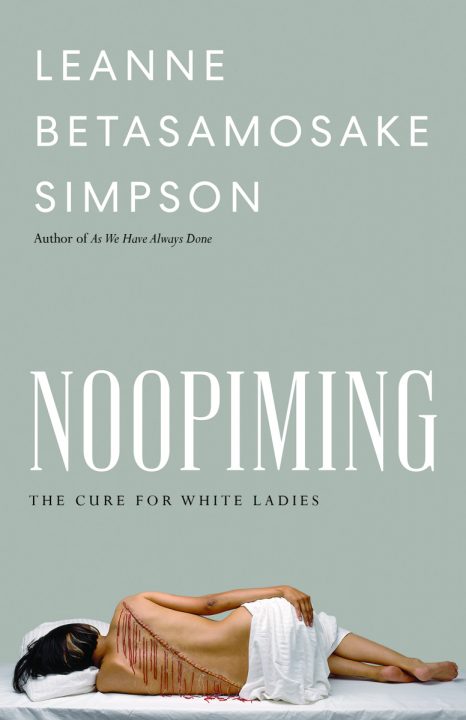
NOOPIMING
The Cure for White Ladies
The new novel from the author of As We Have Always Done, a poetic world-building journey into the power of Anishinaabe life and traditions amid colonialism.
In fierce prose and poetic fragments, Leanne Betasamosake Simpson’s Noopiming braids together humor, piercing detail, and a deep, abiding commitment to Anishinaabe life to tell stories of resistance, love, and joy.
Mashkawaji (they/them) lies frozen in the ice, remembering the sharpness of unmuted feeling from long ago, finding freedom and solace in isolated suspension. They introduce the seven characters: Akiwenzii, the old man who represents the narrator’s will;
The new novel from the author of As We Have Always Done, a poetic world-building journey into the power of Anishinaabe life and traditions amid colonialism.
In fierce prose and poetic fragments, Leanne Betasamosake Simpson’s Noopiming braids together humor, piercing detail, and a deep, abiding commitment to Anishinaabe life to tell stories of resistance, love, and joy.
Mashkawaji (they/them) lies frozen in the ice, remembering the sharpness of unmuted feeling from long ago, finding freedom and solace in isolated suspension. They introduce the seven characters: Akiwenzii, the old man who represents the narrator’s will; Ninaatig, the maple tree who represents their lungs; Mindimooyenh, the old woman, their conscience; Sabe, a gentle giant, their marrow; Adik, the caribou, their nervous system; and Asin and Lucy, the humans who represent their eyes, ears, and brain.
Simpson’s book As We Have Always Done argued for the central place of storytelling in imagining radical futures. Noopiming (Anishinaabemowin for “in the bush”) enacts these ideas. The novel’s characters emerge from deep within Abinhinaabeg thought to commune beyond an unnatural urban-settler world littered with SpongeBob Band-Aids, Ziploc baggies, and Fjällräven Kånken backpacks. A bold literary act of decolonization and resistance, Noopiming offers a breaking open of the self to a world alive with people, animals, ancestors, and spirits—and the daily work of healing.
- University of Minnesota Press
- Hardcover
- February 2021
- 368 Pages
- 9781517911256
About Leanne Betasamosake Simpson
 Leanne Betasamosake Simpson is a Michi Saagiig Nishnaabeg writer, scholar, and musician. A member of Alderville First Nation in Ontario, she is the author of several books, including As We Have Always Done (Minnesota, 2016) and This Accident of Being Lost. Her latest album, The Theory of Ice, will be released in 2021.
Leanne Betasamosake Simpson is a Michi Saagiig Nishnaabeg writer, scholar, and musician. A member of Alderville First Nation in Ontario, she is the author of several books, including As We Have Always Done (Minnesota, 2016) and This Accident of Being Lost. Her latest album, The Theory of Ice, will be released in 2021.
Praise
“Leanne Betasamosake Simpson’s Noopiming once again confirms her position as a brilliant, daring experimentalist and a beautiful, radical portraitist of contemporary NDN life. The prose hums with a lovingness that moved me to tears and with a humor that felt plucked right out of my rez adolescence. The chorus of thinkers, dreamers, revolutionaries, poets, and misfits that Simpson conjures here feels like a miracle. My heart ached and swelled for all of them. What I adored most about this book is that it has so little to do with the white gaze. Simpson writes for us, for NDNs, those made to make other kinds of beauty, to build other kinds of beautiful lives, where no one is looking. Noopiming is a book from the future! Simpson is our much-needed historian of the future!” —Billy-Ray Belcourt, award-winning author of This Wound Is a World and NDN Coping Mechanisms
“I’m pretty sure we don’t deserve Leanne Betasamosake Simpson. But miracles happen, and this is one. This book is poem, novel, prophecy, handbook, and side-eyed critique all at once. This book doesn’t only present characters you will love and never want to leave, it doesn’t only transform the function of character and plot into a visibly collective dynamic energy field (and hallelujah), but it also cultivates character in the reader, that we might remember what we first knew. Which is that what seems separate was never separate. What feels impossible is already happening. And it depends on our most loving words. It requires our most loving actions towards each other. The ceremony has been found.” —Alexis Pauline Gumbs, author of Dub: Finding Ceremony
“Noopiming is a rare parcel of beauty and power, at once a creator and destroyer of forms. All of Leanne Betasamosake Simpson’s myriad literary gifts shine here—her scalpel-sharp humor, her eye for the smallest human details, the prodigious scope of her imaginative and poetic generosity. The result is a book at once fierce, uproarious, heartbreaking, and, throughout and above all else, rooted in love.” —Omar El Akkad, bestselling author of American War
“The tenderness and sly wit of these snippets coalesce into a beautiful image of Native resilience and a piercing, original novel.” —Publishers Weekly
“Simpson’s skill as creator allows those outside Indigenous traditions to apprehend a complexity of meaning-making whose fluidity challenges Western reliance on notions of fixed boundaries and discrete categories of being and nonbeing.” —Star Tribune
“Probably unlike anything you’ve ever read, this remarkable novel is written in prose and fragments and is an alarmingly beautiful tale of decolonial resistance and the uncovering of a world of natural abundance, connection and compassion.” —Ms. Magazine
Discussion Questions
1. The seven main characters in Noopiming, in addition to Maskawaji, use they/them pronouns. How does this impact the reader’s experience of gender in the book?
2. Noopiming takes place in the present. The characters in the novel often shatter contemporary stereotypes and portrayal of Native American and Indigenous peoples. How does this book break open the idea of a novel and how Indigenous stories can be told?
3. Simpson uses satire and humor throughout the book to critique contemporary life. What are some examples of this from the text and how does this enhance the reader’s experience?
4. Noopiming challenges the reader’s idea of linear time and the demarcations of past/present/future in many ways. What is Simpson doing with western ideas of time?
5. Simpson challenges the borders between rural and urban space by setting the story in cities, on reserves, in parks, and in the bush. How does this emphasize the idea that all land is Indigenous land?
6. The cover image is by Anishinaabe artist Rebecca Belmore and is entitled “Fringe.” How do you think this image relates to the themes of the novel?
7. The music video ‘Solidification’ (z.umn.edu/solidification) is a musical and visual interpretation of the beginning of the novel, from Simpson’s album Noopiming Sessions (z.umn.edu/noopimingsessions). How do these artistic projects help Noopiming to travel? Does ‘Solidification’ deepen your understanding of the novel?
8. Simpson uses her language Nishnaabemowin throughout the book, and doesn’t translate the words into English, instead directing readers to an online Ojibwe dictionary. Why do you think she made this decision?
9. Canadian writers Margaret Atwood and Carol Shields have both written works related to Susanna Moodie and Roughing It in the Bush. How does Simpson’s novel relate to this historic work and what do you think she is trying to say about this relationship?
10. Tragedy and trauma exist on the margins of this story. What meaning do you think Simpson is trying to convey to readers by writing adjacent to trauma rather than centering it?
